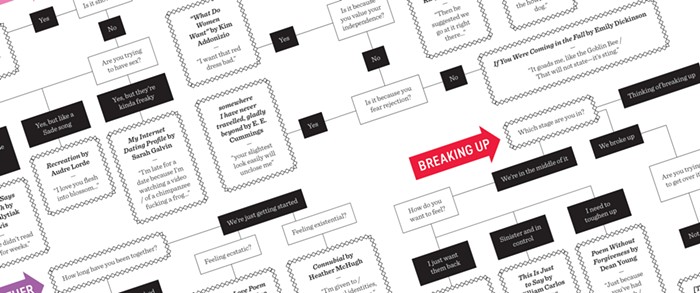For those of you who hope to learn what it's like to read Roberto Bolaño's final, posthumously published, 900-page novel by reading its reviews—I'm sorry, you're out of luck. It can't be done. 2666 is an epic without a center, where all the action can't shake the feeling of stasis, and the thundering cascades of detail may or may not be clues of things to come. (The geometry book hanging from a backyard clothesline on page 134 is. The recipe for a cheese sandwich with pickled onions on page 816 is not.) When it's going full steam, 2666 is as dense and confusing as a fever dream.
And, like a fever dream, it presents mysteries and tensions that are never resolved. Its plot is an absence—a long, narrow borehole filled with cobwebs of digressions. The strands go on for miles and miles, tracing the outline of the plot, but never filling in the central details. 2666, for all its physical heft, is a study in evasions, leaving us nothing we can grip in our teeth—only a cool, eerie atmosphere.
2666 has one constant: The characters—whether they come from Paris, Chile, or Harlem—all eventually have to navigate the eddies of poverty and violence along the U.S.-Mexico border. It's a harsh, dry land of narcos and factory workers, turkey buzzards and grubby cafes, tough guys (boxers, reporters, detectives) and tougher broads (politicians, lawyers, whores), and the occasional anxious and abstracted college professor. A land where, Bolaño writes, "the sky, at sunset, looked like a carnivorous flower."
Bolaño finished 2666 against the deadline of his own death. His liver was rotting from hepatitis C, which he contracted from a dirty needle while he was a young heroin addict, Trotskyite, and vagabond who had fled his native Chile after being jailed by the Pinochet regime. Trying to secure a legacy for his heirs, he instructed his publisher to divide the novel into five parts and publish one part each year, thinking a serial would bring in more money. His heirs rebelled and published 2666 as a single novel in five chapters (spoiler alert—if a novel as sprawling and polyphonic as 2666 can be spoiled):
(1) A trio of European literary critics (who are also in a love triangle) travel to Mexico to search for an elusive German writer named Archimboldi. (2) A Latin American philosophy professor drifts through his days in a fog and learns he is the descendant of clairvoyant Indians. (3) A journalist from Harlem travels to Santa Theresa (a thinly fictionalized Ciudad Juarez) to cover a boxing match. There he learns about the hundreds of young women who have been raped and murdered in recent years, meets the prime suspect, and flees to the U.S., afraid of the cops. (4) A catalog of the murders, and the detectives and journalists trying (or not trying) to solve them. Easily the most horrifying and riveting section, it has the flinty emotional content and casual gore of a mystery novel, and a cooler, more detached tone than the other chapters. This chapter is loosely based on the true and unsolved murders of hundreds of young women in Ciudad Juarez, whose bodies are almost always found in the same way (dumped or barely buried on the outskirts of town) and in the same wrecked condition. By the end of this section, you will have read the phrase "she had been vaginally and anally raped" so many times, you will become queasy, then numb, then queasy again. (5) The life and times of a German boy who loves to swim in the ocean, fights in the Nazi army, and grows up to be an elusive, peripatetic novelist named Archimboldi.
Then there are the digressions, the iridescent snail-trails of Bolaño's fecund brain: the origin of snuff films, a Hungarian general with an enormous penis, an old Black Panther turned barbecue chef, ventriloquists and seers, literary theory, talking rats, Latin American literature, the private lives of medical examiners, how Mexicans think about the U.S. ("There's no place on earth with more dumb girls per square foot than a college in California"), academia, feminism, geometry, jealousy, drugs, Marcel Duchamp, machismo, sexual angst, and writers. Whatever he is writing about, Bolaño is always writing about sexual angst and writers.
Bolaño was clever (and self-absorbed) enough to leave clues to how he wanted readers to think about his novel. Several real-life critics have already cited this passage, in which Amalfitano—the abstracted philosophy professor—is talking to a pharmacist who prefers "The Metamorphosis" to The Trial and "Bartleby" to Moby Dick:
Now even bookish pharmacists are afraid to take on the great, imperfect, torrential works, books that blaze paths into the unknown. They choose the perfect exercises of the great masters. Or what amounts to the same thing: They want to watch the great masters spar, but they have no interest in real combat, when the great masters struggle against that something, that something that terrifies us all, that something that cows us and spurs us on, amid blood and mortal wounds and stench.
In this trick of literary judo, Bolaño dares us to complain that 2666 is too messy, bloated, and unresolved—if we do, we are timid pharmacists and he is Herman Melville. 2666 is messy, bloated, and unresolved (and Bolaño is a kind of Latin American Melville) but it is also rich with stories that cow us and spur us on, amid blood and mortal wounds and the stench of dead women discovered in the Mexican desert. He wants us to lose ourselves in his daisy chains of inferences and unresolved tensions, to keep us curious, anxious, and reading.
The title is mysterious: There is no 2666 in 2666. The prose is also mysterious—flat and journalistic (more so than his other books, which have been celebrated for their Byzantine sentences), but elegant and poetic: "The University of Santa Theresa was like a cemetery that suddenly begins to think, in vain. It also was like an empty dance club." Despite the aforementioned talking rat, he is not a magical realist. Closer to Mario Vargas Llosa than Gabriel García Márquez, Bolaño is a hypnotist—the recurring motifs, the unsolved mysteries (just what does the peripatetic German writer have to do with the Santa Theresa murders?), and his mania for details that may or may not be significant: "The service station was brightly lit and almost empty. Behind the counter, a fifteen-year-old girl was reading a magazine. It looked to Fate as if she had a very small head." Does the size of the girl's head have anything to do with anything? It does not.
With 2666, Bolaño joins that cabal of writers—Jorge Luis Borges, Thomas Pynchon, William Blake—who suck critics, college students, and other literary cryptographers down a hermeneutic rabbit hole. Toward the end of 2666, the peripatetic German novelist is enduring a fellow WWII vet's rambling war memories and thinks to himself:
This man was not only irritating but ridiculous, with the particular ridiculousness of self-dramatizers and poor fools convinced they've been present at a decisive moment in history, when it's common knowledge, thought Archimboldi, that history, which is a simple whore, has no decisive moments but is a proliferation of instants, brief interludes that vie with one another in monstrousness.
Once again, Bolaño is telling us how to think about his writing. Once again, he is right. ![]()
This article has been updated since its original publication.


















